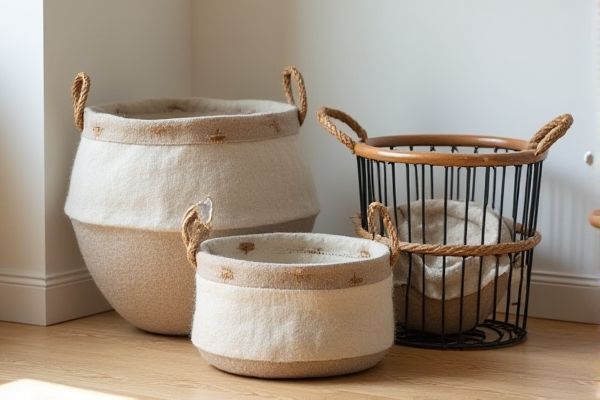
Felt baskets offer a softer, more flexible storage option that prevents scratching and is ideal for delicate items, while wire baskets provide sturdier support and better ventilation, making them perfect for organizing items that need airflow. Discover which basket suits Your storage needs best by exploring the full comparison in the rest of the article.
Table of Comparison
| Feature | Felt Basket | Wire Basket |
|---|---|---|
| Material | Soft, non-woven felt fabric | Durable metal wire (steel or iron) |
| Durability | Moderate, can wear out or tear | High, resistant to bending and breaking |
| Weight | Lightweight and flexible | Heavier and rigid |
| Design | Soft, modern, available in various colors | Open grid structure, industrial or rustic look |
| Breathability | Breathable, prevents moisture build-up | Highly breathable, open design |
| Maintenance | Easy to clean, often washable | Requires wiping, prone to rust if untreated |
| Best Use | Clothing storage, organizing soft items | Storing heavy or bulky items, pantry use |
| Cost | Affordable, varies by quality | Moderate to high, depending on metal quality |
Introduction to Felt and Wire Baskets
Felt baskets are crafted from non-woven fabric made of compressed fibers, offering a soft, flexible, and lightweight storage solution ideal for organizing clothes and toys. Wire baskets, constructed from metal wires in various gauges and finishes, provide rigid, durable, and breathable storage commonly used in kitchens and garages. Both types serve functional and decorative purposes, with felt baskets emphasizing a cozy aesthetic and wire baskets delivering industrial strength and visibility.
Material Composition: Felt vs. Wire
Felt baskets are crafted from non-woven fabric made of compressed natural or synthetic fibers, offering softness, flexibility, and breathability, ideal for delicate storage needs. Wire baskets consist of metal rods or wires, often coated for rust resistance, providing rigidity, durability, and enhanced ventilation. The choice between felt and wire materials impacts the basket's weight, structural integrity, and suitability for different environments or items.
Aesthetic Appeal and Design Options
Felt baskets offer a soft, cozy aesthetic with a variety of colors and patterns, making them ideal for contemporary and minimalist interiors. Wire baskets provide an industrial and modern look, often featuring geometric shapes and a metallic finish that complements urban or rustic decor styles. Both options allow customization, but felt baskets emphasize warmth and texture, while wire baskets highlight structure and openness.
Durability and Longevity Comparison
Felt baskets offer moderate durability with resistance to wear and tear but may degrade faster in humid environments due to moisture absorption. Wire baskets provide superior longevity through their sturdy construction and resistance to corrosion, especially when coated with rust-proof finishes. Choosing between felt and wire baskets depends on the intended use, with wire baskets excelling in heavy-duty and outdoor applications while felt baskets suit lighter indoor storage needs.
Weight and Portability Factors
Felt baskets are lightweight and flexible, making them easy to carry and transport, especially for daily use or short trips. Wire baskets, while more durable and sturdy, tend to be heavier and less portable due to their rigid metal construction. Choosing between the two depends on whether ease of movement or structural strength is the priority.
Storage Capacity and Versatility
Felt baskets offer flexible storage capacity, easily expanding or compressing to fit various items, making them ideal for soft goods like toys, clothes, or blankets. Wire baskets provide a more rigid structure, perfect for stacking and organizing heavier or bulkier items, such as tools or pantry goods, with superior ventilation. Your choice between felt and wire baskets depends on the types of items you need to store and the desired balance between adaptability and sturdiness.
Maintenance and Cleaning Requirements
Felt baskets require gentle cleaning with a damp cloth and mild soap to maintain their soft texture and prevent damage, making them ideal for low-maintenance use. Wire baskets are easy to clean with just a wipe-down or rinse, but they may need occasional rust prevention treatment depending on the material. You should choose felt baskets for a cozy, mess-free option, while wire baskets offer durability with minimal upkeep for rugged storage needs.
Eco-Friendliness and Sustainability
Felt baskets are made from natural or recycled fibers, making them biodegradable and environmentally friendly compared to wire baskets, which are typically produced from metal with higher energy consumption and limited recyclability. The manufacturing process of felt baskets generally has a lower carbon footprint and supports sustainable practices through the use of renewable materials. Wire baskets, while durable, often require mining and smelting processes that contribute to pollution and resource depletion, making felt baskets a preferable choice for eco-conscious consumers.
Cost Analysis: Felt Basket vs. Wire Basket
Felt baskets generally offer lower initial costs compared to wire baskets due to inexpensive materials and simple manufacturing processes. Wire baskets, while typically more expensive upfront, provide greater durability and long-term value by resisting rust and physical damage. When analyzing total cost of ownership, felt baskets may require more frequent replacement, increasing maintenance expenses over time.
Best Uses and Practical Applications
Felt baskets excel in organizing soft, lightweight items such as toys, clothing, and linens due to their flexible, noise-free material that protects delicate surfaces. Wire baskets are ideal for storing heavier items like tools, pantry goods, or office supplies, offering durability and ventilation to prevent moisture buildup. Your choice depends on whether you need gentle containment with a stylish look or strong, open-structure storage for visibility and airflow.
 homyna.com
homyna.com